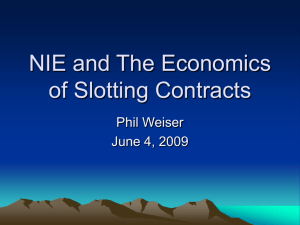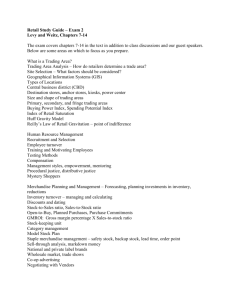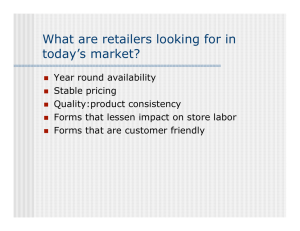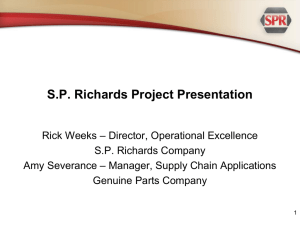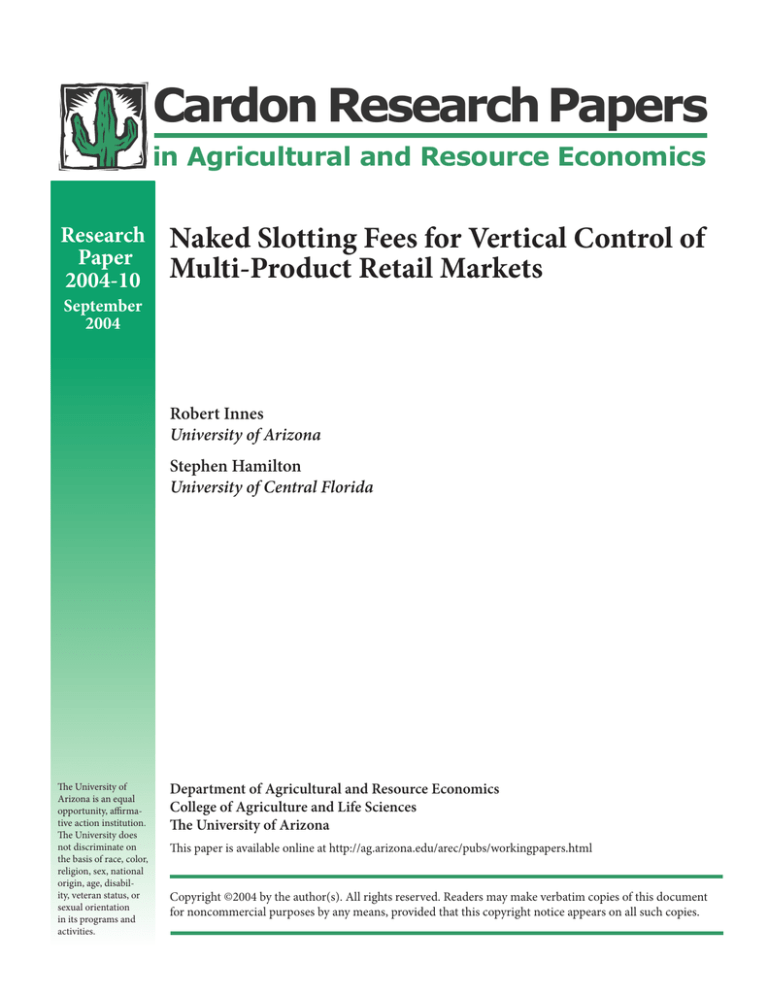
Cardon Research Papers
in Agricultural and Resource Economics
Research
Paper
2004-10
Naked Slotting Fees for Vertical Control of
Multi-Product Retail Markets
September
2004
Robert Innes
University of Arizona
Stephen Hamilton
University of Central Florida
The University of
Arizona is an equal
opportunity, affirmative action institution.
The University does
not discriminate on
the basis of race, color,
religion, sex, national
origin, age, disability, veteran status, or
sexual orientation
in its programs and
activities.
Department of Agricultural and Resource Economics
College of Agriculture and Life Sciences
The University of Arizona
This paper is available online at http://ag.arizona.edu/arec/pubs/workingpapers.html
Copyright ©2004 by the author(s). All rights reserved. Readers may make verbatim copies of this document
for noncommercial purposes by any means, provided that this copyright notice appears on all such copies.
Naked Slotting Fees for Vertical Control of Multi-Product Retail Markets
By
Robert Innes, University of Arizona
Stephen Hamilton, University of Central Florida
Abstract
Slotting fees -- fixed charges paid by food manufacturers to retailers for access to the retail
market -- are both increasingly common and increasingly controversial. This note shows how
imperfectly competitive retailers and a monopolistic supplier of one good can use "naked"
slotting fees -- charges imposed on competitive suppliers of other goods -- to achieve a
vertically integrated multi-good monopoly.
2
Naked Slotting Fees for Vertical Control of Multi-Product Retail Markets
I. Introduction
Slotting fees -- fixed charges paid by food manufacturers to retailers for access to the
retail market -- are both increasingly common and increasingly controversial. Fixed fees are
charged both for stocking of new products (Rao and Mahi, 2003) and for continued stocking of
"old" products (Hamilton, 2003). Criticism of slotting charges is particularly virulent among
small food producers, who claim that the fees are a flagrant form of rent extraction by large
retailers (Prevor, 2000).
The academic literature offers a number of theories for why and when slotting fees
might be charged, and their economic effects. On one side of this literature are theories focused
principally on the charges for new product "slots." A number of scholars (e.g., Chu, 1992;
Richards and Patterson, 2001; Lariviere and Padmanabham, 1997; Desiraju, 2001) argue that
slotting fees can serve as a signaling or screening mechanism whereby new product producers - better informed about the likelihood of their products' success -- can signal their likelihood of
success by paying an upfront bond, or slotting fee. In addition, slotting charges may raise
manufacturers' incentives for post-product-launch promotion (Chu, 1992). Others (most
notably Sullivan, 1997) argue that slotting fees serve to price costly shelf-space in a competitive
market, thereby efficiently equating the damand and supply for product diversity.
A competing literature -- to which the present note contributes -- focuses on the strategic
use of slotting fees in imperfectly competitive marketing chains, theories that apply generically
to any product, new or old. Shaffer (1991a) studies the use of slotting fees by duopolistic
retailers who compete in prices and face competitive suppliers. He finds that a two-part tariff -a slotting fee combined with an elevated wholesale price -- serves to precommit a retailer to a
higher retail price, thus reducing the extent of retail competition, to the retailers' advantage and
society's loss. Hamilton (2003) turns the story around by considering duopolistic
manufacturers who face an up-sloping raw product supply and a competitive retail sector. Here,
a two-part retailer-manufacturer contract stipulates a slotting fee, a wholesale price, and a retailer
3
commitment to accept all supply forthcoming from the manufacturer at the contracted wholesale
price. A slotting fee contract is advantageous to each manufacturer because it implicitly
precommits him to more aggressive quantity competition in the upstream market for raw
product supply; thus, in contrast to Shaffer (1991a), slotting fees are pro-competitive.
While these strategic effects are derived in markets for a single product, we focus
instead on the role of slotting fees when there are multiple products in the marketing chain. In
particular, we consider a monopoly supplier of one product and a competitive industry that
supplies a second product, with both products marketed through duopolistic retailers. In this
context, we study how "naked" slotting fees -- fees imposed on the competitive fringe by
agreement between the monopoly manufacturer and retailers -- can be used to control pricing of
the competitive fringe product to the advantage of the contracting parties. After first showing
that both retail competition and the presence of a second ("fringe") product are necessary for
the emergence of the positive slotting fees observed in practice, we turn to how different types
of contracts -- some constrained to charge the monopoly supplier a symmetric slotting fee, and
others not so constrained -- can be used to achieve the monopoly-cum-retailer optimum.
Notably, these results are consonant with the observed consternation of "small" suppliers over
the imposition of slotting fees by retailers, as opposed to their mutual agreement in contracts (as
in Shaffer, 1991a, and Hamilton, 2003). However, although manufacturer market power is at
the heart of our analysis (as in Hamilton, 2003), we find that slotting fees are strikingly anticompetitive (in contrast to Hamilton, 2003).
This work is closely related to the vertical control literature. For example, Winter
(1993) considers a similar model with a single (monopoly) product, no competitive "fringe,"
duopoly retailers, and an added retailer choice of "service." While he focuses on how vertical
contracts can be used to correct excessive retail price competition, and under-provision of
service, we are interested instead in how contracts -- and slotting fees in particular -- can be used
4
to control pricing of additional products.1 There is also a substantial (and closely related)
literature on extension of monopoly to other products using tying arrangements in vertical
contracts (e.g., Whinston, 1990; Carbajo, et al., 1990; Shaffer, 1991b). This literature focuses
on multi-product producers seeking to extend the advantage enjoyed by their monopolistically
supplied good to other of their products.2 In contrast, the distinct focus here is on how slotting
fee contracts can be used to capture monopoly rents from markets for other firms' products in
the marketing chain.
The remainder of the paper is organized as follows. Section II presents the model and
discusses the centrality of multi-product marketing and retail competition to the emergence of
slotting fees. Section III characterizes baseline outcomes: the choices of a vertically integrated
marketing chain (the first-best) and outcomes absent contracts; here, it is shown that simple
wholesale pricing cannot achieve the first-best. Section IV characterizes first-best slotting fee
contracts. Section V concludes.
II. The Model
Consider a two-good market in which a monopolist produces one good (product 1) and
a competitive industry (fringe) produces the other good (product 2). Monopoly and competitive
fringe production are both at constant marginal cost, c1 and c2 respectively. Both products must
be sold through duopolistic retailers who compete for customers by choice of product prices.
Consumers (the number of whom is normalized to equal one) have preferences over
retailers and products. More specifically, consumers shop at one retail outlet and choose which
outlet based upon a preference parameter q to be discussed in a moment. Given a retail choice,
jÂ{1,2}, and consumption bundle, (y1,y2), a consumer obtains the utility:
2
(1)
u(y1,y2) - Â pji yi,
i=1
1
Adding service, or shelf-space choices, to the present paper's model yields some further insights into the
adverse effects of slotting fees (see Section V below for further discussion); however, it does not alter qualitative
results.
2
Shaffer (1991b), for example, studies how a contract between a multi-product monopolist and a single retailer
can be used by the monopolist to ensure that the retailer stocks the monopolist's full line of products.
5
where
yi = quantity of good i purchased,
pij = price of good i at retailer j,
We assume that u is increasing and concave with bounded first derivatives; u12=0 (the goods
are weak substitutes in consumption);3 and &dln ui / dln yi& = &dln ui / dln yj& for j=/ i (own
good effects dominate). Choosing consumption optimally, a consumer at retailer j obtains the
indirect utility,
(2)
u*j
2
= u*(p1j ,p2j ) = max u(y1,y2) - Â pij yi.
{y1,y2}
i=1
A consumer's retail choice is based upon the preference parameter q, which represents
the consumer's net preference for retailer 2, and is distributed uniformily (in the population of
_ _
consumers) on the support [-q ,q ]. Formally, a q-consumer obtains the utility u*1 if
shopping at retailer 1 and u*2 +q if shopping at retailer 2. Given retail prices, consumers are
thus partitioned according to:
q = q*(u*1 ,u*2 )
purchase from retailer 1,
q > q*(u*1 ,u*2 )
purchase from retailer 2,
where q*(u*1 ,u*2 ) = u*1 -u*2 .
Absent contracts, the monopolist sets a wholesale price w1 and the competitive fringe
prices at cost, w2=c2. In what follows, we will be interested in how equilibrium outcomes
without contracts depart from the optimum for the integrated marketing chain (the "first best").
We will then characterize "slotting fee" contracts that can improve the lot of both the monopolist
and the retailers by achieving their integrated (first-best) outcomes.
Before studying this model, however, it is instructive to briefly consider alternative
frameworks either (a) without retail competition, or (b) with a single product. If the monopoly
wholesaler were faced with a monopoly retailer -- or a retailer subject to an exogenous
3
We denote partial derivatives of u with subscripts, so that (for example), u1 2=?2 u/?y1 ?y2 .
6
consumer "reservation utility" constraint -- an optimal two-part contract between the two firms
would be simple: (1) a marginal cost wholesale price (w1=c1) under which the retailer
maximizes the integrated profit of the marketing chain, and (2) a negative "slotting fee" whereby
the retailer pays the monopoly wholesaler for his share of profit.
Alternately, suppose that we have retail competition, but only over the single (monopolist
wholesaler) product. Then, defining p* as the integrated monopoly retail price, the following is
easily shown:4
Observation 1. If retailers compete only over the single (monopoly wholesaler) product,
(a) there is a wholesale price, w*Â(c1,p*), such that retailers set their retail price
optimally, p1=p*; and (b) in a bargaining equilibrium that splits joint gains from
contracting (more on this below), an optimal two-part contract will set w1=w* and rebate
lost monopoly profits (and the monopolist's share of contracting gains) with a negative
slotting fee.
The intuition for these results is straightforward: With marginal cost wholesale pricing
(w1=c1), each retailer under-prices in order to attract customers from her rival; hence, an abovecost wholesale price, w1=w*, is needed to elicit optimal retail pricing. However, absent
contracts, the monopolist will (in general) set a different wholesale price in order to maximize
his wholesale (rather than integrated chain) profit. Hence, an optimal contract elicits a first-best
by stipulating a different wholesale price than maximizes the monopolist's profit, requiring that
the monopolist be compensated with a negative slotting fee.
In sum, we see that retail competition in multiple products is necessary to provide an
interesting motive for the positive slotting fees observed in practice.
III. First-Best and No Contract Outcomes
In this model, a vertically integrated monopoly solves the following problem:
(3)
4
2
max  (pi-ci)
{p1,p2}
i=1
yi(p1,p2) + P(p1,p2)
{p1*,p2*},
Proofs of Observation 1 and Propositions 2-4 below are contained in the Appendix.
7
2
where yi() + argmax {u(y1,y2) - Â piyi}. The solution to this problem yields the maximum
i=1
profit available in this market, P*+ P(p1*,p2*), and will be called the first-best.
We will first establish that simple wholesale pricing -- and no contracts -- cannot give
rise to a first-best, thus motivating supplier-retailer contracts.5 In doing so, we will describe the
retailer pricing incentives that are central to the design of contracts. Specifically, consider the
choice problem of retailer 1 (R1):6
(4)
2
_
_
p1(p1,p2; u 2,w1,w2) + Â (pi-wi) yi(p1,p2) f(p1,p2; u 2)
{p1,p2}
i=1
2
_
_
= P(p1,p2) f(p1,p2; u 2) - Â (wi-ci) yi(p1,p2) f(p1,p2; u 2)
i=1
max
where w2=c2 and
_
f(p1,p2; u 2) = market share of R1, given R2's price selection (and attendant
_
consumer utility u 2)
_
_
_
= {q +u*(p1,p2)-u 2}/[2q ].
First order necessary conditions for a solution to this problem are:
2
(5)
?p1/?p1 = (?P/?p1) f + P()(?f/?p1) - Â (wi-ci) [(?yi/?p1)f + yi(?f/?p1)] = 0
i=1
2
(6)
?p1/?p2 = (?P/?p2) f + P()(?f/?p2) - Â (wi-ci) [(?yi/?p2)f + yi(?f/?p2)] = 0
i=1
where
(7)
_
_
?f/?pi = (2q )-1 (?u*/?p1) = - (2q )-1 yi(p1,p2) < 0.
Loosely speaking, there are two reasons why the retailer's pricing incentives depart from
those of the vertically integrated chain. First, higher retail prices (ceteris paribus) prompt
marginal consumers to switch to the other retailer; this loss of custom is costly to the retailer,
but of no concern to the vertically integrated chain. (The second terms in eq.s (5)-(6) capture
5
Even if wholesale pricing could achieve a first-best, contracts would be motivated by a divergence between the
monopoly (product 1) supplier's pricing incentives and those of the integrated marketing chain.
6
Choices of retailer 2 are symmetric and thus omitted.
8
these effects.) Second, because the retailer pays an above-cost wholesale price to the monopoly
supplier (w1>c1) -- whereas the vertically integrated chain faces true cost c1 -- retail price effects
on good 1 demand have a smaller impact on retailer profit than on vertically integrated profit.
(The third set of terms in eq.s (5)-(6) captures these effects.)
Following Winter's (1993) logic, the good 1 wholesale price could be set so that these
two effects exactly offset one another for the good 1 retail price; that is, if w1 is chosen so that
the last terms in eq. (5) vanish, then R1 will set p1 optimally:
w1-c1 = P()(?f/?p1)/[(?y1/?p1)f + y1(?f/?p1)] > 0.
(8)
However, with w1 set per eq. (8), the last terms in eq. (6) do not vanish when p2 is set equal to
its integrated optimum, p2*:
(9)
_
?p1(p1*,p2*; u 2,w1,c2)/?p2&eq. (8)
= P* [(?y1/?p1)f + y1(?f/?p1)] -1 f {(?f/?p2)(?y1/?p1) - (?f/?p1)(?y1/?p2)} < 0,
where the inequality is due to ?y1/?p1<0, ?f/?pi<0 (i=1,2), P*>0, f>0, and ?y1/?p2=0 (with
u12=0). Thus, the retailer prefers a lower good 2 price in order to attract custom from the
competition and because the retailer's cost of the lower price, in reduced demand for the
substitute good 1, is lower than for the integrated chain (given w1>c1).
Proposition 1. (A) Simple wholesale pricing cannot achieve the first-best. (B) Closed
territorial division of the market, with w1=c1, will yield the first-best.
With closed territories and marginal cost wholesale pricing, both departures of retailer
incentives from those of the integrated chain, evaporate. However, because consumers
determine where they go, not retailers -- and retailers cannot identify a consumer's preference
location -- we assume that territorial division of the market is impossible.
IV. Contracts
Because a first-best cannot be achieved without contracts, there is potential for contracts
to deliver collective gains. We will assume that contract terms are determined by bargaining,
following standard approaches in the bargaining literature (see, for example, Macleod and
Malcomson, 1995). Rather than dwelling on the precise form of the bargaining game, we
9
simply assume that the game is such that there is a unique subgame perfect equilibrium that
splits collective gains from contract implementation according to a known rule (as in Rubinstein,
1982; Shaked, 1987; and others). The issue of interest here is the form that a first-best contract
can take.
As is often the case, there are many possible contracts that can achieve a first-best. For
example, a "naked" resale price contract that stipulates the first-best price pair (p1*,p2*) will
clearly work, with rent distributed using either (1) a fixed transfer between retailers and the
monopoly (good 1) supplier or (2) a suitable above-cost good-1 wholesale price, w1>c1.
We will focus only on contracts that impose slotting fees on the competitive fringe -fixed fees that entitle a fringe supplier to market access at the retail outlets. For example,
consider a retailer compelled by contract to charge its competitive fringe suppliers a lump-sum
(total) slotting fee of f2>0. The retailer then faces fringe suppliers competing in wholesale
prices (w2) for exclusive access to his retail market at the cost f2; he selects among suppliers
with the lowest wholesale prices on offer. The fixed slotting fee thus confronts the retailer with
a wholesale price that satisfies, in equilibrium, the competitive fringe zero-profit condition,
(10)
(w2-c2)y2(p1,p2) f() = f2.
By eq. (10), "naked" slotting fees imposed on the fringe (good 2) suppliers can be used to
support an above-cost wholesale price, w2>c2. An elevated wholesale price can, in turn, be
exploited to correct retailers' incentives to under-price the fringe product.
(A) Naked Asymmetric Slotting Fees: The Simplest Contract. We first consider a naked
slotting fee contract with a freely chosen transfer between retailers and the monopoly (good 1)
supplier. This contract consists of (1) a fringe slotting fee f2; (2) a monopoly wholesale price
w1; and (3) a monopoly-retailer transfer f1. The last (f1) transfer distributes rents according to
the bargaining equilibrium. Our task is to find wholesale prices that yield a first-best,
(w1*,w2*); given these prices, there are corresponding contract terms that support them:
(11)
w1=w1*
and
f2 = (w2*-c2)y2(p1*,p2*)/2.
10
Formally, we assume that there are unique solutions to the retailers' first-order
_
_
optimality conditions for relevant wholesale prices (w1,w2) and competitor practices (u 1,u 2).
Given retail symmetry, we thus seek a pair (w1,w2) that satisfies eq.s (5)-(6) at p1=p1*, p2=p2*,
_
and u 2=u*(p1*,p2*).7 Doing so yields:
Proposition 2. A naked asymmetric slotting fee contract can support the first-best, with
w1>c1 and f2>0 (so that w2>c2).8
A notable feature of this contract is the asymmetric slotting fee charged the monopoly
(good 1) supplier and the fringe (good 2) suppliers. Indeed, rent transfer to the monopolist can
imply a negative "fee" for the monopolist -- payment to the monopolist from the retailer -- at the
same time as the fringe is charged a positive slotting fee. In some respects, this feature seems
consonant with the euristic empirical observation that larger manufacturers are less likely to pay
slotting fees than are smaller ones (Freeman and Myers, 1987; Rao and Mahi, 2003; Sullivan,
1997, note 9). However, as we turn to symmetric slotting fee contracts next, we will see that this
asymmetry -- and the attendant transparency of the contract's anti-competitive effect -- is not
needed to achieve a first-best.
(B) Naked Symmetric Slotting Fees with Resale Price Maintenance. A symmetric
slotting fee (f=f1=f2) can be used to raise the fringe good's wholesale price, but not to achieve a
desired distribution of rents between retailers and the monopolist. Instead, let the monopolist's
(good 1) wholesale price be used for rent distribution, with good 1 retail pricing incentives
driven by a resale price maintenance contract provision. The monopoly-retailer contract thus
consists of (1) a slotting fee f;9 (2) a good 1 resale price stipulation, p1=p1*; and (3) a
By symmetry, this wholesale price pair will also satisfy retailer 2's optimality conditions at p1=p1*, p2=p2*,
_
and u 1=u*(p1*,p2*).
8
The proof of Proposition 2, contained in the Appendix, derives the stated inequalities, wi >ci , thus establishing
the optimality of a positive slotting fee, f2 >0.
9
In a more realistic model, the slotting fee could be tied to shelf-space and, thus, be different for monopolist and
fringe. However, symmetry will then restrict the slotting fee to reflect common prices of shelf-space across
suppliers. An optimal (integrated chain) shelf-space allocation will thus tie the slotting fees charged the two
suppliers, and prevent their use for desired rent distribution. The foregoing anlysis captures this sort of
restriction in the simplest possible way.
7
11
wholesale price w1. The object of the contract is to achieve first-best retail pricing of the fringe
product (good 2) and to distribute integrated chain profits (P*) to retailers and the monopolist
according to the bargaining equilibrium. Letting pM<P* denote the monopolist's bargained
profit, the latter rent distribution objective requires:
(12)
(w1-c1)y1(p1*,p2) = (w2-c2)y2(p1*,p2) + p M,
where the first right-hand term gives the total (two retailer) slotting fee that the monoplist must
pay in order to support the fringe wholesale price w2. The retailer incentive constraint requires
that eq. (6) be satisfied at p2=p2* (and p1=p1*). Finding the wholesale price pair (w1,w2) that
_
satisfies eq.s (6) and (12) at p1=p1*, p2=p2*, and u 2=u*(p1*,p2*), yields:
Proposition 3. The first-best can be supported by a naked symmetric slotting fee
contract with (1) resale price maintenance, p1=p1*; (2) a positive slotting fee and fringe price
markup, f>0 and w2>c2; and (3) a positive monopoly markup, w1>c1.
(C) Naked Symmetric Slotting Fees with Quantity Contracting. Rather than directly
imposing a retail price on its client retailers -- a practice of dubious legality (Winter, 1993;
Shaffer, 1991a; Butz and Kleit, 2001) -- the monopolist can elicit optimal pricing using a
combination of a fixed quantity commitment (for its good 1 supply) and a slotting fee.10 The
former can be used to peg the good 1 retail price, while the latter controls retail pricing of the
fringe (good 2) product. Profits can then be distributed (as before) by appropriate selection of
the wholesale price w1.
Formally, let q=y1(p1*,p2*)/2 be the optimal quantity commitment, implying the
constraint (for retailer 1),11
(13)
_
y1(p1,p2) f(p1,p2; u 2) = q
_
p1(p2;u 2).
Given wholesale prices and the quantity commitment, R1's problem becomes:
10
The potential symmetry between price and quantity contracts is well-known, although not universal (e.g.,
Reiffen, 1999). Given the widespread use of quantity contracts (e.g., see Calvin, et al., 2001) and their arguable
legal advantages, it is worthwhile to verify their ability to support first-best outcomes in the present model.
11
In general, the retailer will not want to waste output (by not selling the committed quantity). However, for
simplicity, we assume that a fixed quantity contgract commits both the seller (who agrees to supply exactly q)
and the buyer (who agrees to market exactly q).
12
(14)
_
_
_
_
max [p1(p2; u 2)-w1] q + (p2-w2) y2(p1(p2; u 2),p2) f(p1(p2; u 2),p2; u 2).
p2
The attendant first order condition for R1's optimum is:
(15)
(?p1/?p2) [q + (p2-w2) (y21
f + y2 f1)] + [y2f + (p2-w2)(y22
f + y2 f2)] = 0,
where
(?p1/?p2) = - (y12
(16)
f + y1 f2) /(y11
f + y1 f1).
To support a first-best, we need to find a wholesale price w2 such that, in a symmetric
equilibrium, the solution to eq. (15) (and hence, problem (14)) sets p2=p2*;12 optimal good 2
pricing in turn implies optimal good 1 pricing, p1=p1* (by eq. (13) and the definition of q). An
optimal contract sets the slotting fee so as to support this optimal wholesale price w2* (per eq.
(11)), and sets the monopoly wholesale price w1 so as to provide the requisite rent distribution
(per eq. (12)).
Proposition 4. The first-best can be supported by a naked symmetric slotting fee
contract with (1) a fixed monopoly quantity commitment (per retailer), q=y1(p1*,p2*)/2; (2) a
positive slotting fee and fringe markup, f>0 and w2>c2; and (3) a positive monopoly markup,
w1>c1.
V. Conclusion
This paper shows how imperfectly competitive retailers and a monopolistic supplier of
one good can use "naked" slotting fees -- fixed charges imposed on competitive suppliers of
other goods -- to achieve a vertically integrated multi-good monopoly. In view of these anticompetitive effects, this paper suggests that slotting fees merit careful scrutiny under the antitrust laws; in the language of anti-trust doctrine (Cannon and Bloom, 1991), this paper suggests
that slotting fees may be used to achieve predatory discrimination, even when the fees are
symmetrically imposed on all suppliers using the resale price maintenance or fixed quantity
contracts discussed above. This implication is at odds with Hamilton's (2003) conclusion that
_
We assume that, for the optimal w2 * (as characterized below) and u 2 =u*(p1 *,p2 *), there is a unique
solution to eq. (15) which (therefore) uniquely solves problem (14).
12
13
slotting fees may be pro-competitive when product supply is imperfectly competitive. A
distinguishing symptom of Hamilton's (2003) analysis is that slotting fees be at the initiative of
suppliers, as seems to be the case in some instances (bagged salads, for example).13 However,
when slotting fees are paid by "small" suppliers and at the initiative of retailers -- as seems
broadly and increasingly the case (Gibson, 1988; Therrien, 1989; Prevor, 2000; Rao and Mahi,
2003) -- Hamilton's (2003) logic would appear not to apply and the anti-competitive
conclusions of this paper (for multi-good marketing chains with imperfectly competitive
supply) or Shaffer (1991a) (for single-good vertical chains with competitive supply) may
instead be relevant.
The simplified analysis developed in this paper suggests some natural generalizations.
For example, retail outlets may not only make pricing decisions, but also allocate shelf-space.14
In this case, slotting fee contracts may have even more pernicious effects. Absent contracts,
shelf-space allocation decisions will be pro-competitive because concentrated suppliers face an
additional deterrent to elevating wholesale prices -- the prospective loss of shelf-space that will
be allocated to their now-lower-retail-margin products. Slotting fee contracts can end this procompetitive effect by pre-stipulating shelf-space and ostensibly charging for it with a slotting
fee.
In the foregoing analysis, no attention was paid to the enforcability of contracts. For
example, will retailers want -- and be able -- to renege on their pledge to charge slotting fees for
competitive fringe products? On one hand, the logic of Shaffer (1991a) (although complicated
by a multiple product domain) suggests that retailers may want to charge observable slotting
fees to their competitive suppliers, even if they are not compelled to do so by contract. On the
other hand, the calculus of this choice will certainly differ from that determining the monopolyretailer contracts characterized above. There are two possible resolutions to this potential
13
See Calvin, et al. (2001).
Shelf-space may be a form of "service," as studied in Winter (1993). However, in the short-run at least, shelfspace is also different in that it is a fixed resource to be allocated between products, as opposed to a freely
selected service for individual products or collective custom.
14
14
conflict. First, in the case of symmetric slotting fees, any departures from the contractually
stipulated fee for the competitive fringe could be contractually punished by a reduction in the
slotting fee paid by the monopolist. With the fixed quantity contract, for example, the
monopolist could then only be made better off by a retailer's departure from the pre-stipulated
slotting fee -- and the retailers made worse off.15 Second, using a combination of resale price
maintenance (and/or fixed quantity), wholesale price, and fixed transfer contract terms, the
retailers could potentially be provided the needed incentive to set an optimal slotting fee for the
competitive fringe.16
Finally, we have modeled supplier imperfect competition in its starkest form -- that of a
monopoly producer. If there are multiple oligopolistic constant-cost suppliers, then qualitiative
conclusions of the analysis extend directly provided one or more suppliers can bargain with all
retailers. Nevertheless, there are at least two reasons to expect matters to change with oligopoly
supply. First, suppliers and retailers may only be able to bargain unilaterally with one another.
In this case, there will be a Shaffer (1991a) type contracting environment with multiple
products. Second, in a differentiated product market, an incumbent firm may enjoy dominance
at present, but risk losing dominance if consumers become accustomed to a new rival's product.
In this case, the dominant firm has an incentive to deter entry even if total available market profit
is higher with rival production.17 Slotting fees can serve such entry-deterrence purposes.
However, neither of these complications fundamentally alters the logic of "naked" slotting fees
designed to extract rents from competitive product markets in multi-product marketing chains.
15
This does not necessarily rule out a Prisoner's Dilemma outcome in the post-contract retail game, although a
sufficiently large penalty for retailer defections -- that is, a sufficiently large reduction in the monopoly's
slotting payment -- would presumably avoid such an outcome.
16
Characterizing how this can be done is beyond the scope of this note, but will involve an alterred stage game
in which (1) monopoly-retailer contracts are first signed; (2) retailer contracts with fringe suppliers are then
signed; (3) retailers set retail prices; and (4) production and trade occur.
17
See Bernheim and Whinston (1998) for a complete development of this point.
15
Appendix
Proof of Observation 1. Let y(p) denote consumer demand for the single (monopolist)
product. Then
p* = argmax (p-c1)y(p) ƒ y(p)+(p-c1)y'(p) = 0.
(A1)
Retailer 1's choice problem, given wholesale price w, is
_
(A2)
max JR(p;w) = (p-w)y(p)(q +q*),
p
yielding a solution pR(w) that satisfies:
_
(A3)
?JR()/?p = (q +q*)(y+(p-w)y') - y2(p-w) = 0,
with ?q*/?p=-y. For simplicity, we assume that the solution to (A3) -- and hence, pR(w) -- is
unique for relevant w. By symmetry, the monopolist's wholesale price choice problem is:
(A4)
max JM(w) = (w-c1)y(pR(w)).
w
(a) Note that, at w=p=p*,
_
?JR(p*;p*)/?p = (q +q*)(c1-p*)y' > 0,
while at w=c1,
?JR(p*;c1)/?p = -y2(p*-c1) < 0.
By the intermediate value theorem, there is a w*Â(c1,p*) such that ?JR(p*;w*)/?p=0, which (by
symmetry and the uniqueness of (A3)'s solution) establishes part (a).
(b) If the solution to (A4) is w=w*, then a first-best is achieved without contract and no
contracts will be signed. If the solution to (A4) is w=/ w*, then first-best two-part contracts
stipulate w=w*. In a bargining equilibrium, the monopolist receives his base no-contract profit
plus a non-negative share of joint gains from implementation of the first-best. Hence, the fixed
transfer from monopolist to retailers (the slotting fee f) satisfies:
JM(w*) - 2f = max JM(w),
w
where the left-hand-side is the monopolist's payoff under contract and the right-hand-side is his
no-contract payoff. Hence,
f = (1/2) {JM(w*) - max JM(w) } < 0,
w
16
where the second inequality is due to argmax JM(w) =/ w*, and revealed preference. QED.
Proof of Proposition 2. After some tedious manipulations, it can be seen that the
following wholesale price markups will solve eq.s (5)-(6) at p1=p1* and p2=p2* (where
?P/?p1=?P/?p2=0):
(wi-ci) = Ai/B
for i=1,2,
(A6)
Ai = P* f [yii
fj - yij
(A7)
B = (y11
(A5)
_
where, with yij =?yi/?pj and fj=?f/?pj = - (2q )-1 yj(p1,p2) for (i,j)Â{1,2},
f + y1 f1) (y22
fi ] = 0 , j=/ i
f + y2 f2) - (y12
f + y1 f2) ( y21
f + y2 f1)
= ff [y11 y22 -y21 y12 ] + f [ y11 y2f2 + y22 y1f1 - y21 y1f2 - y12 y2f1] = 0.
The inequalities in (A6)-(A7) are due to yii <0 (for i=1,2); fi<0 (for i=1,2); with u12=u21=0 (by
s
assumption), yij = -uij=0 (for j=/ i, (i,j)Â{1,2}); and, by concavity of u, y11 y22 -y21 y12 >0.
Provided f>0, the inequalities in (A6)-(A7) are strict; hence, evaluating A1,A2, and B at f=1/2,
p1=p1*, and p2=p2* yields eq. (A5) wholesale prices, w1*>c1 and w2*>c2, that implement the
first-best. QED.
Proof of Proposition 3. Solving eq.s (12) and (6) jointly for (w2-c2), with p1=p1* and
p2=p2*, yields
(w2-c2) = C/D,
(A8)
where
(A9)
C = (P*-pM) y1 f2 - pM y12 f < 0
(A10)
D = y2 (y12
f + y1 f2) + y1 (y22
f + y2 f2)
= f u1 [(dln u1/ dln y1) - (dln u1/dln y2)] + 2y1y2f2 < 0.
The inequalities in (A9)-(A10) follow from 0<pM<P*, y12 =0, dln u1/ dln y1 < 0, and (by
assumption) &dln u1 / dln y1& = &dln u1 / dln y2&. Evaluating C and D at f=1/2, p1=p1* and
p2=p2* yields eq. (12) and eq. (A8) wholesale prices that implement the first-best, with w2>c2
by (A8)-(A10), and w1>c1 by eq. (12), w2>c2, and pM>0. QED.
Proof of Proposition 4. We need to find a w2=w2*>c2 that satisfies eq. (15) at p2=p2*
_
(and hence, p1=p1*), u
1*,p2*), and f=1/2 (by symmetry of the equilibrium).
2 =u*(p
17
Evaluating eq. (15) at the latter values by substituting eq. (16) and (from the definitions of p1*,
p2*, and q=y1f),
y2 + (p2-w2) y22 = - {(w2-c2)y22
q + (p2-w2)y21 f = - f {(w2-c2)y21
+ (p1-c1)y12 }
+ (p1-c1)y11 }
we can collect terms to yield
(15')
(y11
f + y1 f1)-1 {(w2-c2) E + F} = 0,
where
(A11)
E = (y21
f + y2 f1) (y12
f + y1 f2) - (y22
f + y2f2) (y11
f + y1 f1)
= - B < 0,
(A12)
F = f P* [y11 f2 - y12 f1] > 0,
where B is defined in eq. (A7) and the inequalities follow from f=1/2>0, eq. (A7), P*>0, yii
<0, yij =0 (j=/ i), and fi<0. From (15') and (A11)-(A12), w2* satisfies: (w2-c2)=-F/E>0.
QED.
18
References
Bernheim, B. and M. Whinston. "Exclusive Dealing." Journal of Political Economy 106
(1998): 64-103.
Butz, D. and A. Kleit. "Are Vertical Restraints Pro- or Anticompetitive? Lessons From
Interstate Circuit." Journal of Law & Economics 44 (2001): 131-59.
Calvin, L., R. Cook, M. Denbaly, C. Dimitri, L. Glaser, C. Handy, M. Jekanowski, P. Kaufman,
B. Krissoff, G. Thompson, S. Thornsbury. "U.S. Fresh Fruit and Vegetable
Marketing." Ag. Economic Report Number 795, U.S.D.A. Economic Research Service
(2001).
Cannon, J. and P. Bloom. "Are Slotting Allowances Legal Under Antitrust Laws?" Journal of
Public Policy & Marketing 10 (1991): 167-86.
Carbajo, J., D. de Meza, and D. Seidmann. "A Strategic Motivation for Commodity Bundling."
Journal of Industrial Economics 38 (1990): 283-97.
Chu, W. " Demand Signaling and Screening in Channels of Distribution." Marketing Science
11 (1992): 327-47.
Desiraju, R. "New Product Introductions, Slotting Allowances and Retailer Discretion."
Journal of Retailing 77 (2001): 335-58.
Freeman, L. and J. Myers. "Grocery Fee Hampers New-Product Launches." Advertising Age
(August 3, 1987)
Gibson, R. "Supermarkets Demand Food Firms' Payments Just to Get on the Shelf." Wall
Street Journal (Nov. 1, 1988): 1.
Hamilton, S. "Slotting Allowances as a Facilitating Practice by Food Processors in Wholesale
Grocery Markets: Profitability and Welfare Effects." American Journal of Agricultural
Economics (2003, in press).
Lariviere, M. and V. Padmanabham. "Slotting Allowances and New Product Introductions."
Marketing Science 16 (1997): 112-28.
19
Macleod, W.B. and J. Malcomson. "Contract Bargaining with Symmetric Information."
Canadian Journal of Economics 28 (1995): 336-67.
Prevor, J. "Dictates from Retailers." Produce Business (September, 2000): 8.
Rao, A. R. and H. Mahi. "The Price of Launching a New Product: Empirical Evidence on
Factors Affecting the Relative Magnitude of Slotting Allowances." Marketing Science
22 (2003): 1-23.
Reiffen, D. "On the Equivalence of Resale Price Maintenance and Quantity Restrictions."
International Journal of Industrial Organization 17 (1999): 277-88.
Richards, T. and P. Patterson. "Slotting Allowances as Real Options: An Alternative
Explanation." J. Business (2002).
Rubinstein, A. "Perfect Equilibrium in a Bargaining Model." Econometrica 50 (1982): 97-109.
Shaffer, G. "Slotting Allowances and Resale Price Maintenance: A Comparison of Facilitating
Practices." RAND Journal of Economics 22 (1991a): 120-135.
Shaffer, G. "Capturing Strategic Rent: Full-Line Forcing, Brand Discounts, Aggregate Rebates,
and Maximum Resale Price Maintenance." Journal of Industrial Economics 39
(1991b): 557-75.
Shaked, A. "Opting Out: Bazaars Versus 'Hi-Tech' Markets." Theoretical Economics
Discussion Paper 87/159, London School of Economics (1987).
Sullivan, M. "Slotting Allowances and the Market for New Products." Journal of Law &
Economics 40 (1997): 461-93.
Terrien, L. "Want Shelf Space at the Supermarket? Ante Up." Business Week (August 5,
1989): 60.
Whinston, M. "Tying, Foreclosure and Exclusion." American Economic Review 80 (1990):
837-59.
Winter, R. "Vertical Control and Price Versus Nonprice Competition." Quarterly Journal of
Economics 108 (1993): 61-76.



